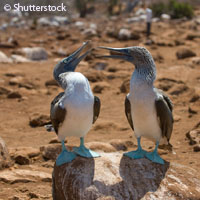The ageing effects of birds
Contrary to popular belief, wild birds do in fact age before they die. This is the finding of a new study from Spain and Mexico, presented in the Journal of Evolutionary Biology. Led by the University of Vigo in Spain, the study spotlighted ageing of the blue-footed booby (Sula nebouxii) in terms of the bird's capacity to live and reproduce. For the longest time, researchers believed that wild animals died before they had a chance to get old. 'It was always thought that senescence (approaching an advanced age) was something particular to humans and domestic animals, because we have an extended life expectancy,' the Scientific Information and News Service (SINC) quotes Alberto Velando, a researcher at the Ecology and Animal Biology Department of the University of Vigo, as saying. 'Senescence exists in wild animals' reproduction and living capacity.' In their study, the researchers used a database with information compiled over a 30-year period, to assess a population of the blue-footed booby found along the Pacific coasts of Mexico, the Galapagos Islands and Peru. Their aim? To shed light on the ageing patterns of this long-lived bird species. Their data indicate that the germline, what experts define as the deoxyribonucleic acid (DNA) sequence passed from one generation to the next, is not free of injury. 'The DNA of the sperm of older individuals is damaged,' Professor Velando says. 'This means their offspring have a greater likelihood of suffering from congenital illnesses.' This study establishes that humans are not the only organisms to suffer from genetic disorders. A recent study showed how children of men aged over 50 or 60 have a higher risk of being diagnosed with genetic illnesses. It is the same situation for the blue-footed booby. 'It was thought that this was of no importance in nature,' says Professor Velando, 'and that it was a defect of our civilisation, since we live longer than a natural lifespan. However, it turns out that this happens in nature too.' According to the researchers, the colour of the blue-footed booby's feet changes with age. This change mirrors the oxidative damage sustained by their sperm. It should be noted that the female birds favour males on the basis of foot colour; they are more attracted to younger males with bright feet. This selection pattern ensures their offspring will not be affected by genetic mutations. In a nutshell, the findings confirm that the average middle-aged male has a less deteriorated germline and more colourful feet. 'This study helps shed light on selection patterns, and the evolutionary and growth patterns of populations,' the Vigo researcher explains. 'The study provides us with a new way of looking at what lies behind sexual signals, pointing to the importance of sexual selection in eliminating genetic mutations.' Researchers from Universidad Nacional Autónoma de México contributed to this study.For more information, please visit: University of Vigo: http://www.uvigo.es/uvigo_en/index.html(opens in new window) Journal of Evolutionary Biology: http://www.blackwellpublishing.com/jeb_enhanced/(opens in new window)
Countries
Spain, Mexico



